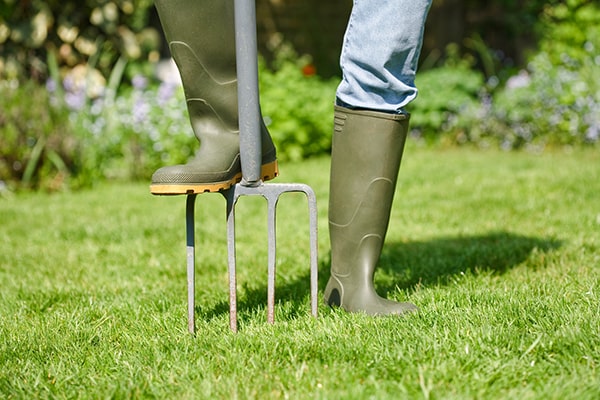
While many gardeners enjoy taking care of their flowers and other plants, some often do so to the detriment of their lawns. The lawn is sometimes overlooked and not given the same amount of care or concern as a garden. This is a mistake. The lawn is often the backdrop upon which the garden is viewed. After all, most gardens sit within and/or around the larger part of the plot of land, which is the lawn. There are a couple of considerations that should be given to the lawn. The most evident is the general and regular maintenance of the lawn during the spring and summer that will surely improve its health and appearance. The other consideration is the care it should be given during the autumn to prepare the lawn for a healthy spring.
Spring and Summer Lawn Maintenance
Mowing the Lawn
The best outcome for a lawn comes from regular maintenance and cutting. This keeps the lawn thick, tidy, and it deters the growth of weeds. In the spring or the start of the growing year, mower blades should be set at approximately 3cm (1.25 inches). The lawn should be cut once per week. As the lawn begins to grow faster (during spring and summer), the blades should be lowered to a height of 2cm (1 inch). At this time, the lawn may also need to be cut twice per week. The general rule is to mow less frequently during long dry spells. In addition to letting the grass grow longer, it is important to avoid using summer feeds that affect new growth. Also avoid using the sprinkler during droughts and simply get used to the tendency that the lawn will turn brown. When the autumn rains appear, the lawn will recover its colour.
Tidy Lawn Edges
Not only does tidying the edges of the lawn keep it from spreading into the borders, but it also gives the grass a neat appearance. Long-handled edging shears or a rotary trimmer can be used to trim grass that hangs over the edges after mowing. Each spring a half-moon edging tool should be used to re-cut the edges. Straight cuts can be made by using the tool against a plank of wood. Cuts along a curve can be assisted by the use of an old hosepipe that is laid upon the ground. The vertical edge looks best at about 7cm deep. Do not despair if there are edges that require repair. It is actually easy to repair parts of an edge using a spade to slice through the turf. A small rectangular piece can be simply cut from around the damaged area. The trick is to face the damaged edge toward the lawn by lifting from the ground with the spade and turning it around. Finally, press the turned damaged part down firmly and then fill the area that is damaged with compost. This area can now be repaired by sowing grass seed over the compost and watering the area.

Do Not Starve the Lawn
Lawns can be made greener and thicker by simply regularly feeding them with a lawn fertiliser. Having a thicker lawn, as a result of feeding, also helps it to resist weeds and moss. The formulations of fertiliser are important to consider because there are different ones for different times of the year. There are also fertiliser formulas that help to weed the lawn by killing moss whilst also feeding it by providing nutrients to the grass.
Weed Removal
Do not expect a lawn to be completely free from weed growth; in fact, it would be helpful to become tolerant of a few weeds. However, it is when the weeds appear in small patches or certain single weeds need to be removed that a daisy grubber tool or similar device can be beneficial. Using a device like this helps to ensure the deeper roots of perennial weeds are extracted.
Patch Repairs
Many lawns suffer from uneven areas, such as a lawn with a sunken patch. These patches can be repaired by using a half-moon edging tool to make an H-shaped spade cut across it. After the cut, simply pull back the two flaps of turf over the hollow. Once the area is exposed, topsoil can be added, levelled, and the flaps can then be firmed down. Any gaps created by the cuts can then be filled with more topsoil. Some areas of lawns are walked upon with frequency, which can cause the trampled lawn to wear away. When there are areas of a lawn that are utilised more as a walking path, the ugliness of the worn path can be prevented by laying down stepping-stones. Slices of turf can be dug out to allow the installation of paving slabs. The turf should be dug out in such a way that the paving stones can be placed just beneath the surface of the lawn. This allows a mower to pass over the stepping-stones with safety and convenience.
Autumn Lawn Maintenance
Autumn leaves falling from trees and bushes should be raked up regularly because they can stop the sunlight from getting to the lawn, creating weak patches of grass. These areas can then be overtaken by moss. Furthermore, dead leaves left on the lawn during winter create an ideal place for snails and slugs to hide. Use a flexible plastic teeth rake for areas like borders, which may have other plants so the plants are not pulled out along with the leaves. The lawn should then be raked to clear away dead grass, moss, and other debris. The rake also creates aerating holes in the lawn. Ideally, the lawn should be top-dressed with a mix of 50/50 sand and fine compost. Finally, feed the lawn with an autumn fertiliser mix that is a special low-nitrogen feed. The rewards of these autumn efforts will be evident the following spring.




